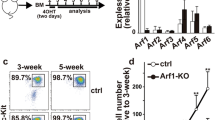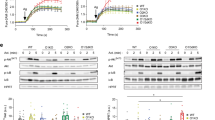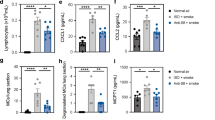Abstract
Mast cells elicit allergic responses through degranulation and release of proinflammatory mediators after antigen crosslinking of the immunoglobulin E receptor FcεRI. Proteins of the 'regulator of G protein signaling' (RGS) family negatively control signaling mediated by G protein–coupled receptors through GTPase-accelerating protein activity. Here we show that RGS13 inhibited allergic responses by physically interacting with the regulatory p85α subunit of phosphatidylinositol-3-OH kinase in mast cells and disrupting its association with an FcεRI-activated scaffolding complex. Rgs13−/− mice had enhanced immunoglobulin E–mediated mast cell degranulation and anaphylaxis. Thus, RGS13 inhibits the assembly of immune receptor–induced signalosomes in mast cells. Abnormal RGS13 expression or function may contribute to disorders of amplified mast cell activity, such as idiopathic anaphylaxis.
This is a preview of subscription content, access via your institution
Access options
Subscribe to this journal
Receive 12 print issues and online access
$209.00 per year
only $17.42 per issue
Buy this article
- Purchase on Springer Link
- Instant access to full article PDF
Prices may be subject to local taxes which are calculated during checkout







Similar content being viewed by others
References
Metz, M. & Maurer, M. Mast cells–key effector cells in immune responses. Trends Immunol. 28, 234–241 (2007).
Ra, C., Jouvin, M.H. & Kinet, J.P. Complete structure of the mouse mast cell receptor for IgE (FcεRI) and surface expression of chimeric receptors (rat-mouse-human) on transfected cells. J. Biol. Chem. 264, 15323–15327 (1989).
Fukao, T. et al. Selective loss of gastrointestinal mast cells and impaired immunity in PI3K-deficient mice. Nat. Immunol. 3, 295–304 (2002).
Ali, K. et al. Essential role for the p110δ phosphoinositide 3-kinase in the allergic response. Nature 431, 1007–1011 (2004).
Gilfillan, A.M. & Tkaczyk, C. Integrated signalling pathways for mast-cell activation. Nat. Rev. Immunol. 6, 218–230 (2006).
Nguyen, M. et al. Receptors and signaling mechanisms required for prostaglandin E2-mediated regulation of mast cell degranulation and IL-6 production. J. Immunol. 169, 4586–4593 (2002).
Zhong, H. et al. Activation of murine lung mast cells by the adenosine A3 receptor. J. Immunol. 171, 338–345 (2003).
Olivera, A. & Rivera, J. Sphingolipids and the balancing of immune cell function: lessons from the mast cell. J. Immunol. 174, 1153–1158 (2005).
Jolly, P.S. et al. Transactivation of sphingosine-1-phosphate receptors by FcεRI triggering is required for normal mast cell degranulation and chemotaxis. J. Exp. Med. 199, 959–970 (2004).
Gilman, A.G. G proteins: transducers of receptor-generated signals. Annu. Rev. Biochem. 56, 615–649 (1987).
Willars, G.B. Mammalian RGS proteins: multifunctional regulators of cellular signalling. Semin. Cell Dev. Biol. 17, 363–376 (2006).
Druey, K.M. Bridging with GAPs: receptor communication through RGS proteins. Sci. STKE [online] 104, RE14 (2001) (doi:10.1126/stke.2001.1104.re1114).
Hernandez-Hansen, V. et al. Increased expression of genes linked to FcεRI Signaling and to cytokine and chemokine production in Lyn-deficient mast cells. J. Immunol. 175, 7880–7888 (2005).
Taymans, J.M., Leysen, J.E. & Langlois, X. Striatal gene expression of RGS2 and RGS4 is specifically mediated by dopamine D1 and D2 receptors: clues for RGS2 and RGS4 functions. J. Neurochem. 84, 1118–1127 (2003).
Laffargue, M. et al. Phosphoinositide 3-kinase γ is an essential amplifier of mast cell function. Immunity 16, 441–451 (2002).
Heximer, S.P., Watson, N., Linder, M.E., Blumer, K.J. & Hepler, J.R. RGS2/G0S8 is a selective inhibitor of Gqα function. Proc. Natl. Acad. Sci. USA 94, 14389–14393 (1997).
Fukao, T., Terauchi, Y., Kadowaki, T. & Koyasu, S. Role of phosphoinositide 3-kinase signaling in mast cells: new insights from knockout mouse studies. J. Mol. Med. 81, 524–535 (2003).
Yu, M., Lowell, C.A., Neel, B.G. & Gu, H. Scaffolding adapter Grb2-associated binder 2 requires Syk to transmit signals from FcεRI. J. Immunol. 176, 2421–2429 (2006).
Gu, H. et al. Essential role for Gab2 in the allergic response. Nature 412, 186–190 (2001).
Yamanashi, Y. et al. Activation of Src-like protein-tyrosine kinase Lyn and its association with phosphatidylinositol 3-kinase upon B-cell antigen receptor-mediated signaling. Proc. Natl. Acad. Sci. USA 89, 1118–1122 (1992).
Cuevas, B.D. et al. Tyrosine phosphorylation of p85 relieves its inhibitory activity on phosphatidylinositol 3-kinase. J. Biol. Chem. 276, 27455–27461 (2001).
Zhu, M., Rhee, I., Liu, Y. & Zhang, W. Negative regulation of FcεRI-mediated signaling and mast cell function by the adaptor protein LAX. J. Biol. Chem. 281, 18408–18413 (2006).
Andrade, M.V., Hiragun, T. & Beaven, M.A. Dexamethasone suppresses antigen-induced activation of phosphatidylinositol 3-kinase and downstream responses in mast cells. J. Immunol. 172, 7254–7262 (2004).
Zhang, J., Berenstein, E.H., Evans, R.L. & Siraganian, R.P. Transfection of Syk protein tyrosine kinase reconstitutes high affinity IgE receptor-mediated degranulation in a Syk-negative variant of rat basophilic leukemia RBL-2H3 cells. J. Exp. Med. 184, 71–79 (1996).
Reischl, I.G., Coward, W.R. & Church, M.K. Molecular consequences of human mast cell activation following immunoglobulin E-high-affinity immunoglobulin E receptor (IgE-FcεRI) interaction. Biochem. Pharmacol. 58, 1841–1850 (1999).
Vanhaesebroeck, B., Ali, K., Bilancio, A., Geering, B. & Foukas, L.C. Signalling by PI3K isoforms: insights from gene-targeted mice. Trends Biochem. Sci. 30, 194–204 (2005).
Nechushtan, H., Leitges, M., Cohen, C., Kay, G. & Razin, E. Inhibition of degranulation and interleukin-6 production in mast cells derived from mice deficient in protein kinase Cβ. Blood 95, 1752–1757 (2000).
Leitges, M. et al. Protein kinase C-δ is a negative regulator of antigen-induced mast cell degranulation. Mol. Cell. Biol. 22, 3970–3980 (2002).
Zhang, C., Hirasawa, N. & Beaven, M.A. Antigen activation of mitogen-activated protein kinase in mast cells through protein kinase C-dependent and independent pathways. J. Immunol. 158, 4968–4975 (1997).
Olenchock, B.A. et al. Impaired degranulation but enhanced cytokine production after FcεRI stimulation of diacylglycerol kinase ζ-deficient mast cells. J. Exp. Med. 203, 1471–1480 (2006).
Kitaura, J. et al. Akt-dependent cytokine production in mast cells. J. Exp. Med. 192, 729–740 (2000).
Dong, B., Valencia, C.A. & Liu, R. Ca2+/calmodulin directly interacts with the pleckstrin homology domain of AKT1. J. Biol. Chem. 282, 25131–25140 (2007).
Popov, S.G., Krishna, U.M., Falck, J.R. & Wilkie, T.M. Ca2+/Calmodulin reverses phosphatidylinositol 3,4, 5-trisphosphate-dependent inhibition of regulators of G protein-signaling GTPase-activating protein activity. J. Biol. Chem. 275, 18962–18968 (2000).
Hollinger, S. & Hepler, J.R. Cellular regulation of RGS proteins: modulators and integrators of G protein signaling. Pharmacol. Rev. 54, 527–559 (2002).
Lu-Kuo, J.M., Fruman, D.A., Joyal, D.M., Cantley, L.C. & Katz, H.R. Impaired kit- but not FcεRI-initiated mast cell activation in the absence of phosphoinositide 3-kinase p85α gene products. J. Biol. Chem. 275, 6022–6029 (2000).
Bernstein, L.S., Grillo, A.A., Loranger, S.S. & Linder, M.E. RGS4 binds to membranes through an amphipathic α-helix. J. Biol. Chem. 275, 18520–18526 (2000).
Tesmer, J.J., Berman, D.M., Gilman, A.G. & Sprang, S.R. Structure of RGS4 bound to AlF4--activated Giα1: stabilization of the transition state for GTP hydrolysis. Cell 89, 251–261 (1997).
Heximer, S.P. & Blumer, K.J. RGS proteins: Swiss army knives in seven-transmembrane domain receptor signaling networks. Sci. STKE [online] 370, pe2 (2007)(doi:10.1126/stke.3702007pe3702002).
Wang, X. et al. Spinophilin regulates Ca2+ signalling by binding the N-terminal domain of RGS2 and the third intracellular loop of G-protein-coupled receptors. Nat. Cell Biol. 7, 405–411 (2005).
Liu, W. et al. Adrenergic modulation of NMDA receptors in prefrontal cortex is differentially regulated by RGS proteins and spinophilin. Proc. Natl. Acad. Sci. USA 103, 18338–18343 (2006).
Hague, C. et al. Selective inhibition of α1A-adrenergic receptor signaling by RGS2 association with the receptor third intracellular loop. J. Biol. Chem. 280, 27289–27295 (2005).
Han, S.B. et al. Rgs1 and Gnai2 regulate the entrance of B lymphocytes into lymph nodes and B cell motility within lymph node follicles. Immunity 22, 343–354 (2005).
Shi, G.X., Harrison, K., Wilson, G.L., Moratz, C. & Kehrl, J.H. RGS13 regulates germinal center B lymphocytes responsiveness to CXC chemokine ligand (CXCL)12 and CXCL13. J. Immunol. 169, 2507–2515 (2002).
Estes, J.D. et al. Follicular dendritic cell regulation of CXCR4-mediated germinal center CD4 T cell migration. J. Immunol. 173, 6169–6178 (2004).
Beadling, C., Druey, K.M., Richter, G., Kehrl, J.H. & Smith, K.A. Regulators of G protein signaling exhibit distinct patterns of gene expression and target G protein specificity in human lymphocytes. J. Immunol. 162, 2677–2682 (1999).
Youssef, L.A. et al. Histamine release from the basophils of control and asthmatic subjects and a comparison of gene expression between “releaser” and “nonreleaser” basophils. J. Immunol. 178, 4584–4594 (2007).
Saitoh, S. et al. LAT is essential for FcεRI-mediated mast cell activation. Immunity 12, 525–535 (2000).
Dombrowicz, D., Flamand, V., Brigman, K.K., Koller, B.H. & Kinet, J.P. Abolition of anaphylaxis by targeted disruption of the high affinity immunoglobulin E receptor α chain gene. Cell 75, 969–976 (1993).
Manetz, T.S. et al. Vav1 regulates phospholipase cγ activation and calcium responses in mast cells. Mol. Cell. Biol. 21, 3763–3774 (2001).
Nagahara, H. et al. Transduction of full-length TAT fusion proteins into mammalian cells: TAT-p27Kip1 induces cell migration. Nat. Med. 4, 1449–1452 (1998).
Acknowledgements
We thank S. Dowdy (University of California, San Diego, School of Medicine) and J.S. Gutkind (National Institute of Dental and Craniofacial Research, National Institutes of Health) for plasmids; S. Iwaki and A. Gilfillan for reagents, protocols, discussions and critical review of the manuscript; J. Kehrl (National Institute of Allergy and Infectious Diseases, National Institutes of Health) for anti-RGS13 and D. Metcalfe for support.
Author information
Authors and Affiliations
Contributions
G.B., Z.X. and K.D. did experiments, analyzed data and wrote the paper; and S.R. and K.H.N. did experiments and analyzed data.
Corresponding author
Ethics declarations
Competing interests
K.H.N. and S.R. were employees of USB Pharma when the microarray data were collected.
Supplementary information
Supplementary Text and Figures
Supplementary Figures 1–9 (PDF 686 kb)
Rights and permissions
About this article
Cite this article
Bansal, G., Xie, Z., Rao, S. et al. Suppression of immunoglobulin E–mediated allergic responses by regulator of G protein signaling 13. Nat Immunol 9, 73–80 (2008). https://doi.org/10.1038/ni1533
Received:
Accepted:
Published:
Issue Date:
DOI: https://doi.org/10.1038/ni1533
This article is cited by
-
A revised airway epithelial hierarchy includes CFTR-expressing ionocytes
Nature (2018)
-
Integrating energy calculations with functional assays to decipher the specificity of G protein–RGS protein interactions
Nature Structural & Molecular Biology (2011)
-
Regulation of G-protein-coupled signaling pathways in allergic inflammation
Immunologic Research (2009)
-
New developments in mast cell biology
Nature Immunology (2008)



